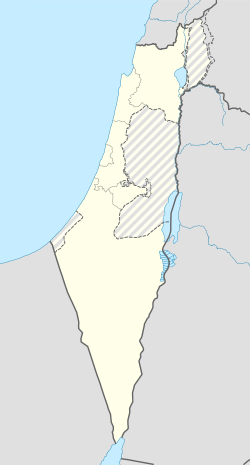Zemer
Arab town in central Israel From Wikipedia, the free encyclopedia
Zemer (Hebrew: זמר, Arabic: زيمر) is an Arab local council in the Central District of Israel. It is located in the Arab Triangle area, between Baqa al-Gharbiyye and Bat Hefer on Road 574. Zemer is the result of a merger of four villages – Bir al-Sika, Ibtan, Marja and Yama - in 1988.
Zemer
| |
|---|---|
Local council (from 1988) | |
| Hebrew transcription(s) | |
| • ISO 259 | Zemr |
 | |
| Coordinates: 32°22′4″N 35°1′59″E | |
| Grid position | 154/197 PAL |
| Country | Israel |
| District | Central |
| Founded | 1988 (merger) |
| Government | |
| • Head of Municipality | Yassin Harzalla |
| Area | |
• Total | 8,203 dunams (8.203 km2 or 3.167 sq mi) |
| Population (2022)[1] | |
• Total | 7,457 |
| • Density | 910/km2 (2,400/sq mi) |
| Name meaning | Khurbet Ibthan; meaning "Ruin of gardens, or of soft soil"[2] |
History
Summarize
Perspective
Before the Common Era
Archaeological work in Yama brought to light settlement remains ranging from the Pre-Pottery Neolithic B (PPNB) to the Ottoman period.[3] At Ibtan, potsherds dating from the Hellenistic, Roman and Byzantine period have been found.[4]
Middle Bronze Age II findings from Yama have been tentatively identified to belong to the ancient site of Yaham.[3] Yaham was mentioned in Egyptian sources regarding pharaohs Thutmose III and Shoshenq I.[5] The 15th century BCE annals describing the campaign of Thutmose III against a coalition of Canaanite city-states recount how the pharaoh camped at Yaham before marching on through the pass of Aruna (today's Wadi Ara), at whose exit he attacked and captured the city of Megiddo.[5]
Mamluk Sultanate and Ottoman Empire
In 1265, two of the villages were mentioned among the estates which the Mamluk sultan Baibars granted his emirs after he had defeated the Crusaders: The whole of Ibthan (Bathan) was given to his emir 'Alam al-Din Sanjar al-Halabi al-Salihi,[6] while Yamma was divided equally between the emirs Saif al-Din Itamish al-Sa'di and Shams al-Din Aqsunqur.[7]
Yama and Ibtan appeared in Ottoman tax registers compiled in 1596, in the Nahiyas of Qaqun and Jabal Sami, respectively, of the Nablus Liwa. Yama had a population of 18 Muslim households and 5 bachelors, while Ibtan was indicated as empty even though it paid taxes.[8]
In 1882, in the PEF's Survey of Western Palestine, only Khurbet Ibthan was noted, with "traces of ruins and a well."[9]
British Mandate and Israel
In the 1922 census of Palestine conducted by the British Mandate authorities, Bir al-Sikka had a population of 36, Ibthan 56 and Yamma 48, all Muslims.[10] Until 1948, all four villages were administratively related to the modern-day Palestinian town of Deir al-Ghusun.[11][12]
Zemer's population at the end of 2009 was 5,700,[13] and its jurisdiction is 8,203 dunams.[14] The population increased to 6,375 in 2014.[15] The mayor of Zemer is Yassin Harzalla.[16]
References
Bibliography
External links
Wikiwand - on
Seamless Wikipedia browsing. On steroids.


